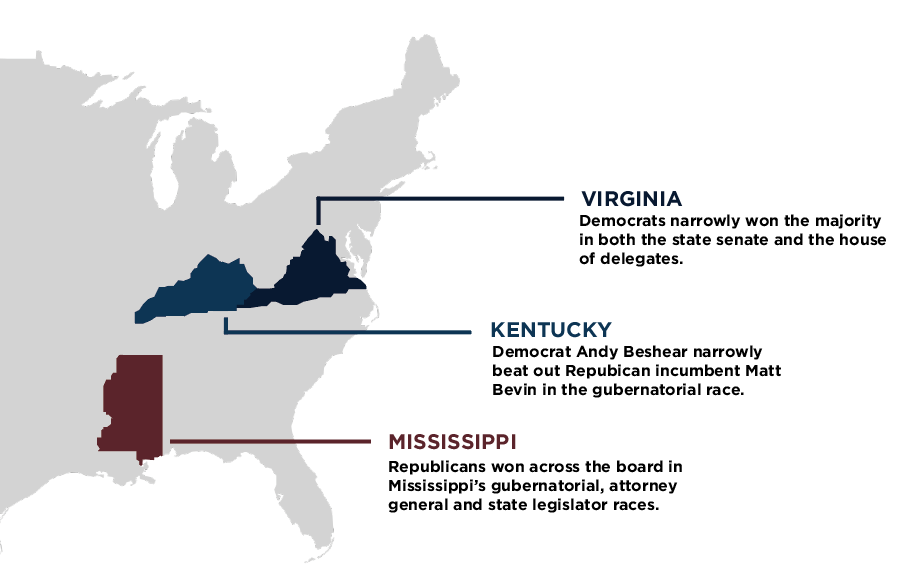
By Morgan Hopkins, Staff Reporter
Tuesday, Nov. 5 marked Election Day for many states, including gubernatorial elections in Kentucky and Mississippi and state legislative elections in Mississippi and Virginia.
Kentucky
Although the Democratic candidate was ahead by 5,100 votes with 100 percent of the precincts counted, Republican incumbent Gov. Matt Bevin refused to concede the election to Democratic frontrunner Attorney General Andy Beshear. Beshear won 49.2 percent of the vote compared to Bevin’s 48.8 percent, making him the clear winner of the election. After the election, Beshear claimed himself the winner and made the announcement to his supporters that he hopes the incumbent will “honor the election”. Gov. Bevin on the other hand suggested to his supporters that there were “irregularities” in the election, but failed to provide any additional details. Republicans won in both the Kentucky State Senate (36-16) and in the state House (74-44). This meant a clean sweep for Republicans for Kentucky’s state government.
Mississippi
Mississippi held both state legislative elections and gubernatorial elections, which resulted in victories for Republicans in both cases. Due to term limits, Republican incumbent Gov. Phil Bryant would be vacating his seat at the end of this term, leaving the frontrunners to be Republican Lt. Gov. Tate Reeves and right-leaning Democrat Attorney General Jim Hood. Establishment Republicans like Lt. Gov Reeves tend to be more elitist and politically moderate and are considered to be out of touch with traditionally conservative voters. Although a registered Democrat, Attorney General Hood is anti-abortion and pro-guns. Lt. Gov. Reeves captured the office with 52.1 percent of the vote compared to Hood’s 46.6 percent. nt.
Virginia
This election cycle, Virginia held elections for both gubernatorial and state legislature seats up for election. What is monumental is that Virginia flipped and became more Democratic leaning. It is important to note that Virginia’s urban and suburban areas became more blue and more rural areas became more red. The Virginia Democrats won the majority in both the House of Delegates and the state Senate, which makes for the first time since 1944 that Democrats hold control of Virginia’s state government.
What do the results mean?
First, it is important to notice that there is a Democrat-leaning trend emerging across the country. Although President Trump still maintains a strong base in rural parts of the country, experts are noticing that suburban and urban areas, even where Republican strongholds exist, are becoming more left-leaning. Additionally, in the 2020 presidential election, based on last week’s elections, it is very likely that there will be an unprecedentedly high voter turnout around the country. With people like Stacey Abrams, a former Georgia state legislator and 2018 Georgia gubernatorial candidate, working to combat it with initiatives like Fair Fight 2020, there will be a spotlight surrounding voter suppression.
Howard University junior and Mississippi Native, Natalyah Davis, commented on her experiences with voting in her state. “I applied for my absentee ballot, but it never came,” said Davis. “[For] as long as I could remember, back home there would be roadblocks stopping people from voting. When I tried to call about my absentee ballot, no one could give me a straight answer.” In the coming months, the narrative surrounding voter suppression are expected to be centerstage in the media, especially with the role it could potentially play in voter turnout for the 2020 presidential election.
An average taken from three Moody prediction models still puts President Trump on top for the 2020 presidential election, according to CNN. Compared to Trump’s 305 in the 2016 elections, it is predicted that he will win 332 electoral votes to the Democratic candidate’s 206. The Moody model has only incorrectly predicted one election since its creation: the 2016 election.

